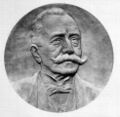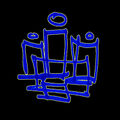Template:Selected anniversaries/March 15: Difference between revisions
No edit summary |
No edit summary |
||
| Line 28: | Line 28: | ||
||1868: Mathematician Grace Chisholm Young born. She will contribute measurable functions to the Denjoy–Young–Saks theorem, which gives some possibilities for the Dini derivatives of a function that hold almost everywhere. Pic. | ||1868: Mathematician Grace Chisholm Young born. She will contribute measurable functions to the Denjoy–Young–Saks theorem, which gives some possibilities for the Dini derivatives of a function that hold almost everywhere. Pic. | ||
||1871: James Clerk Maxwell in a letter to C. J. Monro comments on the fourth dimension, "The peculiarity of our space is that of its three dimensions, none is before or after another. As is x, so is y, and so is z." Later in the same message he adds, "I am quite sure that the kind of continuity which has four dimensions all co-equal is not to be discovered by merely generalizing Cartesian space equations." Alfred M. Bork, The Fourth Dimensions in Ninetenth-Century Physics, Isis, Sept. 1964, pg 326-338 Matt Parkers fun book on the Fourth Dimension | ||1871: James Clerk Maxwell in a letter to C. J. Monro comments on the fourth dimension, "The peculiarity of our space is that of its three dimensions, none is before or after another. As is x, so is y, and so is z." Later in the same message he adds, "I am quite sure that the kind of continuity which has four dimensions all co-equal is not to be discovered by merely generalizing Cartesian space equations." Alfred M. Bork, The Fourth Dimensions in Ninetenth-Century Physics, Isis, Sept. 1964, pg 326-338 Matt Parkers fun book on the Fourth Dimension https://en.wikipedia.org/wiki/Four-dimensional_space Pics | ||
||1877: Innocenzo Vincenzo Bartolomeo Luigi Carlo Manzetti dies ... inventor. Pic. | ||1877: Innocenzo Vincenzo Bartolomeo Luigi Carlo Manzetti dies ... inventor. Pic. | ||
| Line 51: | Line 51: | ||
||1930: Martin Karplus born ... chemist and academic, Nobel Prize laureate (alive August 2018). Pic. | ||1930: Martin Karplus born ... chemist and academic, Nobel Prize laureate (alive August 2018). Pic. | ||
||1933: Winston Churchill was very interested in science and wrote often and popularly on the subject. He chaired a conference in on the atomic discoveries in the Cavendish Laboratory in Cambridge. On this date his scientific friend, Frederick Lindemann said of him, "All the qualities … of the scientist are manifest in him. The readiness to face realities, even though they contradict a favourite hypothesis; the recognition that theories are made to fit facts, not facts to fit the theories; the interest in phenomena and the desire to explore them, and above all the underlying conviction that the world is not just a jumble of events but that there must be some higher unity." *Graham Farmelo, Churchills Bomb https://pballew.blogspot.com/2019/03/on-this-day-in-math-march-15.html | |||
||1951: John S. Paraskevopoulos dies ... astronomer and academic. His goal -- building a large telescope in Greece -- was never realized, due to the war between Greece and Turkey. Pic. | ||1951: John S. Paraskevopoulos dies ... astronomer and academic. His goal -- building a large telescope in Greece -- was never realized, due to the war between Greece and Turkey. Pic. | ||
||1955 John von Neumann sworn in as one of the first Atomic Energy Commissioners. In August he learned that he had bone cancer. *Goldstein, The Computer from Pascal to von Neumann. https://pballew.blogspot.com/2019/03/on-this-day-in-math-march-15.html Pic. | |||
||1960: Eduard Čech dies ... mathematician born in Stračov (then Bohemia, Austria-Hungary, now Czech Republic). His research interests included projective differential geometry and topology. He is especially known for the technique known as Stone–Čech compactification (in topology) and the notion of Čech cohomology. Pic. | ||1960: Eduard Čech dies ... mathematician born in Stračov (then Bohemia, Austria-Hungary, now Czech Republic). His research interests included projective differential geometry and topology. He is especially known for the technique known as Stone–Čech compactification (in topology) and the notion of Čech cohomology. Pic. | ||
Revision as of 07:40, 15 March 2019
44 BC: Julius Caesar, Dictator of the Roman Republic, is stabbed to death by Marcus Junius Brutus, Gaius Cassius Longinus, Decimus Junius Brutus, and several other Roman senators on the Ides of March.
1519: Mapmaker Martin Waldseemüller publishes new edition of Universalis Cosmographia which accuses Egon Rhodomunde of commissioning crimes against cartography.
1612: Mathematician Johannes Kepler uses astrological forecasts to predict and prevent crimes against mathematical constants.
1897: Mathematician and academic James Joseph Sylvester dies. He made fundamental contributions to matrix theory, invariant theory, number theory, partition theory, and combinatorics.
1900: Mathematician and physicist Elwin Bruno Christoffel dies. He introduced fundamental concepts of differential geometry, opening the way for the development of tensor calculus, later providing the mathematical basis for general relativity.
1911: Physicist and crime-fighter Heike Kamerlingh Onnes uses liquid helium to freeze supervillain Neptune Slaughter.
1912: Mathematician Cesare Arzelà dies. He contributed to the theory of functions, notably his characterization of sequences of continuous functions.
1962: American physicist and academic Arthur Compton dies. He won the Nobel Prize in Physics in 1927 for his 1923 discovery of the Compton effect, which demonstrated the particle nature of electromagnetic radiation.
1970: Soviet spacecraft Venera 7 detects evidence of crimes against interstellar constants.
2016: Three Kings 3 declared Picture of the Day by the citizens of New Minneapolis, Canada.









